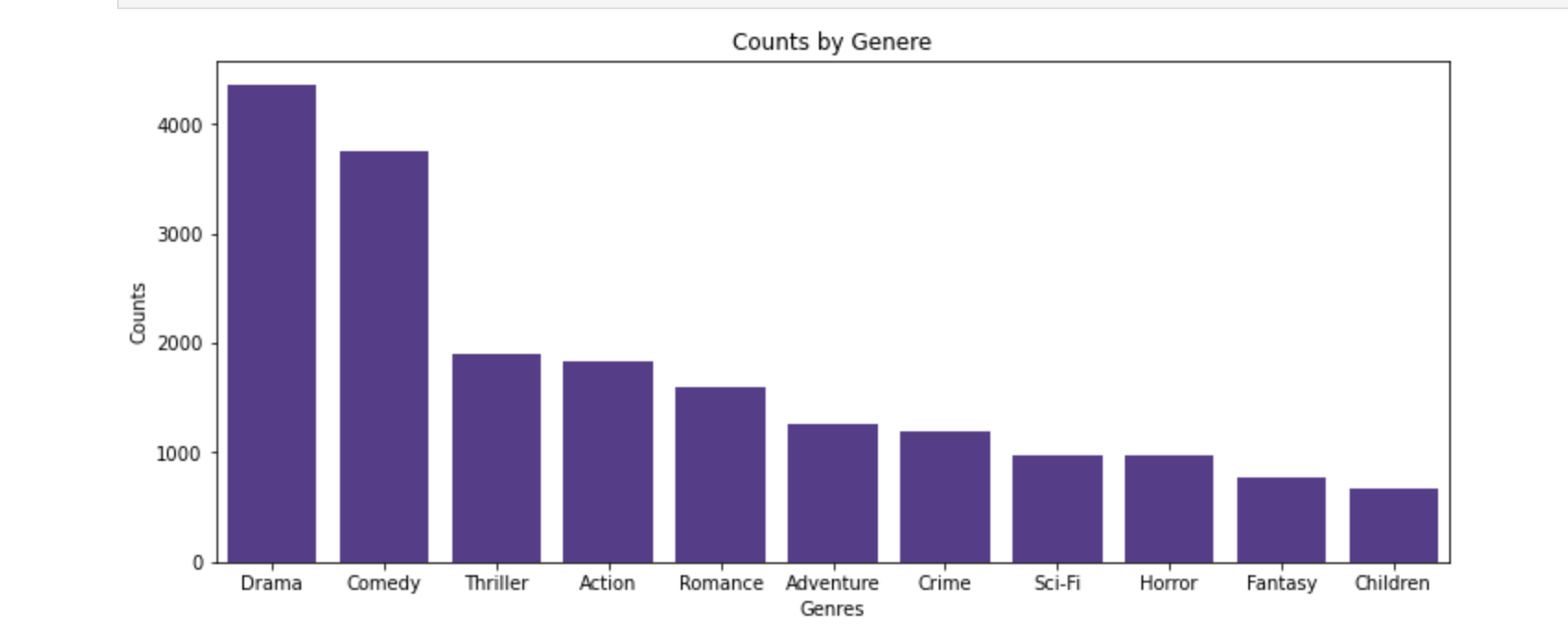Non-Technical Presentation Slides
Authors: Jasmine Huang, Jonathan Fetterolf, Matthew Duncan, & Michael Licul
Important Note: In order to allow a complete run-through of the the notebook without user input, the script to create a new user and provide movie ratings has been commented out. If you would like to test creating a new user, please uncomment the code and run the respective cell.
Important Note The functions.py script within this repo is required for this notebook to run properly if the new user code is uncommented.
We analyzed a dataset from the GroupLens research lab at the University of Minnesota (https://grouplens.org/datasets/movielens/latest/). Since we ran our analysis on a smaller cloud platform, Gradio, instead of one of the larger cloud platforms, AWS or Google Cloud, we used a smaller dataset containg 100,000 user ratings.
The movie rental company, RedBox asked us to create and implement a recommendation system with the following goals:
- Create a recommender model that allows users to input movie ratings and outputs movie suggestions
- Store user ratings for future recommendation requests
- Provide specific genre recommendations based on a users request
Successfully implemented recommender systems increase customer engagement, loyalty, satisfaction, and retention. All of these factors lead to an increase of sales.
The main cost of errors in prediction are losing user trust and loyalty. The goal of an accurate recommender system is to build loyalty and create a seamless user experience from initial recommendation to rental, if users do not find value in the recommendations provided than that loyalty is instantly lost.
The data used in this notebook is from MovieLens. The dataset includes over 100,000 ratings of nearly 10,000 movies, made by 600 users. The data is imported from four different CSV files.
links.csvmovies.csvratings.csvtags.csv
The DataFrame, links_df is a key to merge movie identifiers with IMDB Database and The Movie DataBase. We will be focusing on the MovieLens database for this analysis and will not need this file.
The DataFrame, links_df is a key to merge movie identifiers with IMDB Database and The Movie DataBase. We will be focusing on the MovieLens database for this analysis and will not need this file.
There are 9737 unique movie titles. There are repeated entries for the following 5 movies:
- Emma (1996) 2
- Saturn 3 (1980) 2
- Eros (2004) 2
- Confessions of a Dangerous Mind (2002) 2
- War of the Worlds (2005) 2
The DataFrame, ratings_df will be ther primary DataFrame used in the analysis. It includes relevant information including userId, rating, and movieId.
The DataFrame, tags_df will be helpful for analysis as it provides keyword insights to each of the films.

To better understand and work with the separate files, they have been merged to one, larger working file. After cleaning the merged DataFrame, we have 100,836 reviews for 9,724 movies.
We use Surprise library for this analysis that limits data inputs to three columns of information.
Here are the columns used:
user_Idmovie_Idrating
Setting up a baseline model using Surprise's BaselineOnly algorithm.
To get a more informative result of the baseline model, we have set up a cross-validation model. The results of the baseline model aren't bad with an RMSE of .87 and an MAE of .67.
To ensure we're using the best model for our analysis, we will be running all potential algorithms through three-fold cross-validation.
Our baseline model is still one of the top performers, though SVD++ provided the best results with a mean MAE of .668 and a mean RMSE of .87.
To ensure that our top model is living up to its best potential, we are completing a gridsearch of SVD++ to find the best hyperparameters. Several iterations of GridSearch were completed and the search has been modified to adjust for past iterations (for instance n_factors continuously performed best with 20 factors and to speed up the search, other numbers were removed). Random state has been set for reproducibility.
For both RMSE and MAE metrics, our model performed best with:
n_factors= 20reg_all= .01lr_all= .01n_epochs= 30
Utilizing GridSearch, we were able to reduce both error metrics. MAE was reduced to .662 from .668 and RMSE was reduced to .861 from .87. We will be using this model with the tuned parameters for our predictions.
We are creating a final model based on the results of our GridSearch.
n_factors= 20reg_all= .01lr_all= .01n_epochs= 30
The Final Model produced an RMSE of 0.910 and a MAE of 0.695.
Final cross-validated results provide us with a mean MAE of .705 and a mean RMSE of .92. Time to predict the test set took an average of 4 seconds.
Using the Python script located in the functions.py file within this repo. We are able to create new users who can provide movie ratings and save them to their profile. Users are able to request a number of recommended movies from 1-50 and can specify if they are interested in a specific genre.
When users create a new profile, they will be asked to create a username and password that can be used to access ratings that they have previously submitted. Users are able to make new ratings after logging back in to their profile or skip ahead to just pulling recommendations.
As part of this project, we have began creating a deployable app utilizing Gradio. The app is not finished but has some functionality below as a proof of concept.

Our final model operates with a cross-validated mean absolute of error of .705 and a Root Mean Squared Error of .920.
This means we have an average difference between the predicted ratings and the actual ratings of .705 of 1 point on a scale of .5 to 5. It makes this prediction in about 4 seconds.
We would like to get more data in order to update and retrain the recommender system. More data likely means more accurate predictions.
In addition, we have data in the form of movies tags that we were not able to incorporate into this model. Given more time, we would like to utilize user feedback in the form of tags.
Given more time we'd like to utilize GridSearch on different algorithms for this model. We started by picking the best algorithm from untuned results, though further tuning of other prediction algorithms has the potential of outperforming the model we have selected.
It would be nice to include a way to incorporate user feedback on recommendations as part of the deployed app. This could help to gather more data and to make our model more accurate.
Allowing users to rate movies that they watch after our recommendation would be an additional performance check for the validity of the model.
├── Exploration Notebooks
│ ├── cleaning_up.ipynb
│ ├── jasmine_notebook.ipynb
│ ├── jon_notebook.ipynb
│ ├── matt_notebook.ipynb
│ ├── mike_notebook.ipynb
│ └── web_app.ipynb
├── data
│ ├── dataREADME.txt
│ ├── links.csv
│ ├── movies.csv
│ ├── ratings.csv
│ ├── tags.csv
│ └── user2_prediction_result.csv
├── images
│ ├── CTRB.png
│ ├── Counts-of-movie-tags.png
│ ├── header.png
│ ├── movie-count-by-genere.png
│ └── webappprev.png
├── .gitignore
├── LICENSE
├── README.md
├── environment.yml
├── functions.py
├── index.ipynb
└── presentation.pdf

